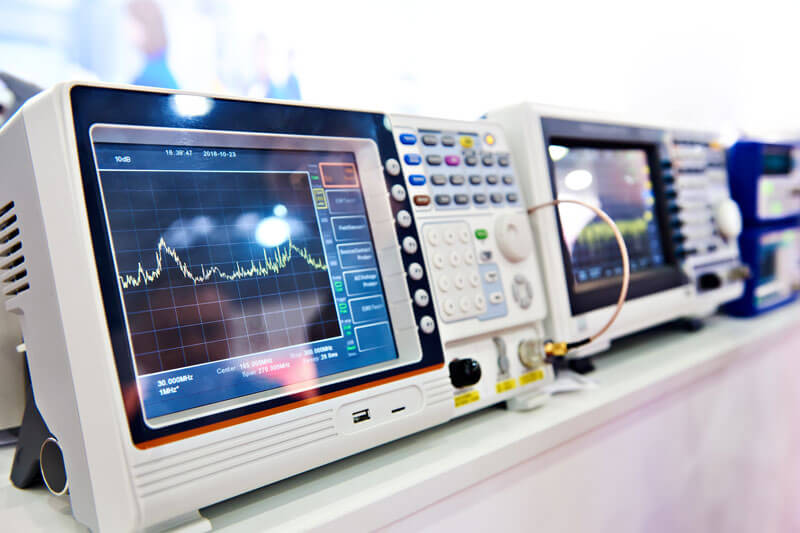
Short Range Devices (SRD) are low TX power radio communication devices (typically 10mW, with some bands permitting up to 500mW), operating in the Industrial Scientific Medical (ISM) bands and a few other similarly unlicensed allocations. There are many such radio modules using different modulation technologies and protocols.
Radiometrix specialise in low current consumption, direct FM/FSK radio modules without any protocol overhead, allowing embedded systems engineers to use efficient proprietary protocols and manipulate their data format and timing at the bit and packet level, without needing to integrate excessively high performance, power hungry CPUs. This also facilitates precise control over transmit burst length and duty cycles, so optimising power consumption for battery operated devices which can be called on to last several years in the field.
In addition to simpler ISM radios, Radiometrix also provides custom development of more sophisticated, higher power narrow band (12.5kHz or 25kHz) FM multi-channel radios for high-end security and defence industry customers, and a large selection of integrated protocol “radio modems” and dedicated control orientated products.
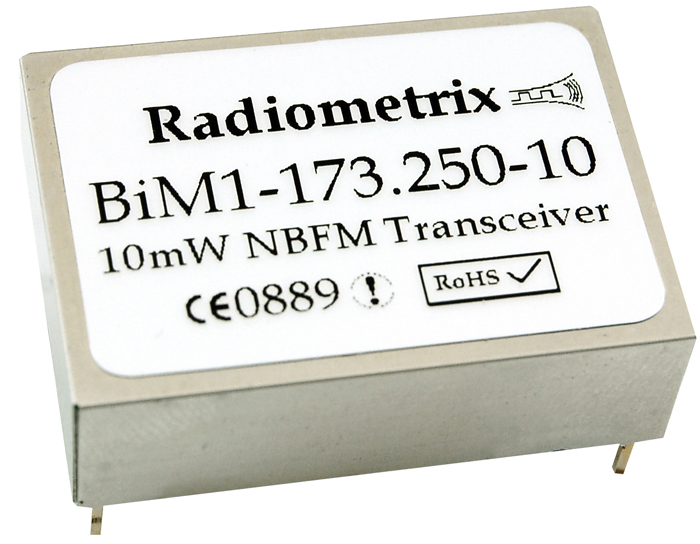
Very High Frequency (VHF) radio modules provide the best operating range for fixed wireless telemetry and/or telecommand networks due to the relatively lower path loss, combined with the superior receive sensitivity of the narrowband systems required in these bands (assuming the necessary aerials can be accommodated).
Typical applications: Automatic Wireless Irrigation Control, Automatic Meter Reading (AMR), Fire Alarms
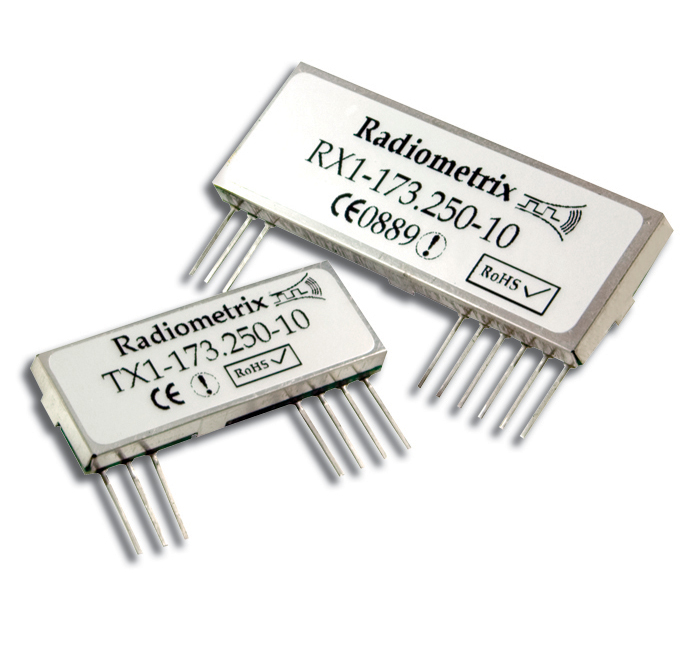
Single Frequency modules are lower cost, smaller modules consuming less current. A variety of Narrow Band VHF or UHF, and Wide Band UHF types, are available.
Single Frequency modules are suitable for most of the applications where there is no need for multiple transmitter-receiver pairs to be working simultaneously, or in applications in which data loss due to a collision is not critical (for example, in a temperature monitoring system in a food warehouse, a number of transmitters on the same frequency can be allowed to infrequently send their sensor readings, with a randomised timing jitter being used to minimise the likelihood of multiple sequential collisions, although absolute data throughput is low).
Operating frequency for a single frequency module is determined by a custom frequency crystal, or a fixed ratio (programmed) PLL. Radiometrix can supply custom VHF and UHF frequency modules. For example, single channel VHF modules can be supplied between 120-174MHz subject to an MOQ and lead-time.
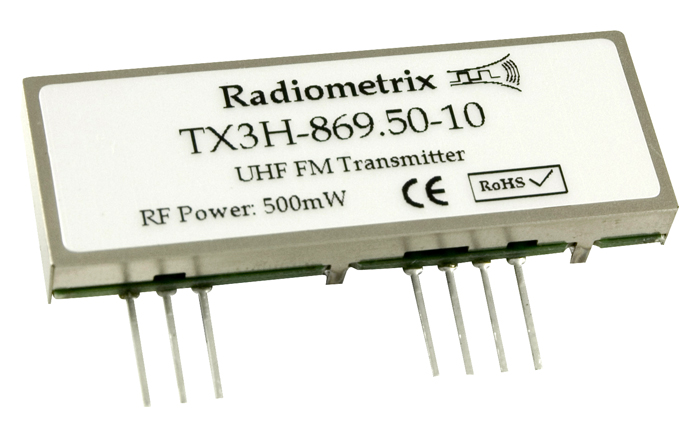
Where the band regulations allow wider transmit spectra (in the 433MHz ISM band for example), it is possible to employ this popular class of lower cost, smaller modules with a wider bandwidth, offering higher data rates up to 64 (or even 160) kbps. Due to their wider receiver bandwidth, sensitivity will be lower, reducing their typical operating range to about 200-300m line of sight with 10mW RF transmit power, compared to the 500m+ of the more costly narrowband alternatives.
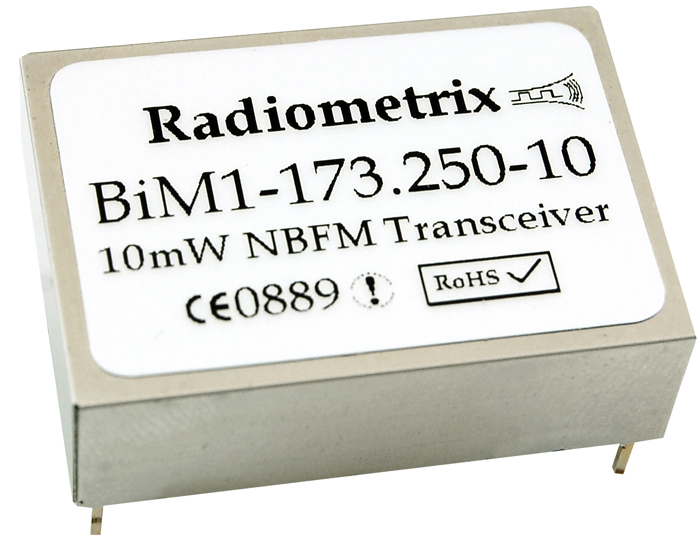
“Narrow Band FM” refers in our case to modules with channel spacings of 12.5kHz or 25kHz. These provide better operating range for a given transmit power, due to the higher receiver sensitivity (down to -118dBm for 12dB SINAD, or better). They also allow access to more tightly restricted operating bands where TX higher powers are often allowed (such as the 458MHz industrial band, where 500mW is legal).
However, due to their lower bandwidth, data rate is restricted to 5-10kbps maximum. Narrowband radios typically offer much tighter RF performance parameters than the simpler, cheaper wideband units, offering greatly improved resistance to interferers in and out of band, and so far greater link reliability.
Some particularly high-performance narrowband radios in the Radiometrix product range (such as the COR3 social alarm band receiver) fulfil the requirements of the EN300-220 regulation's “Category one” limits (intended for radios used in highly critical applications).
Key data sheet parameters to identify a genuine high-performance category one NBFM radio (receiver)
(cheaper RF IC based narrow band modules can rarely offer this level of performance).
Practically all VHF bands require narrowband operation, while certain countries like Japan and South Korea permit only (in this case 12.5kHz) NBFM to be used for their UHF ISM band applications too. In the USA a number of FCC regulated frequency bands require 12.5kHz NBFM operation (such as VHF/UHF radios for FCC Part 90 licensed usage).
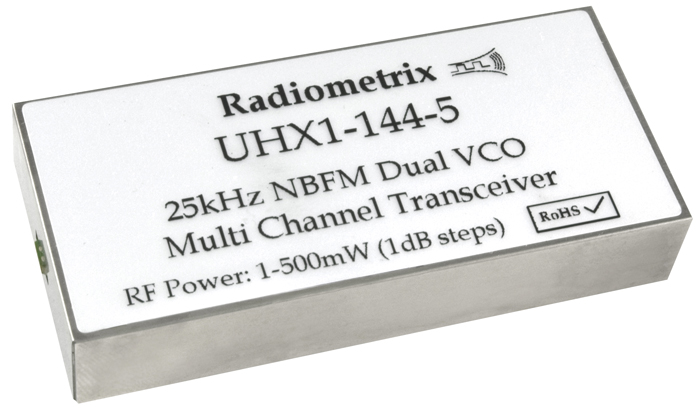
Frequency synthesiser based multi-channel modules allow a multi-user application to share the same operating band in the same locality, with minimum interference to each other. For example, the 433MHz ISM band will only accommodate a few (at faster data rates: one) wideband radio link(s), while narrowband multichannel systems can (for example) fit over sixty 25KHz channels into that same 433.05-434.79MHz allocation.
To take an example, in an industrial control system where there is no coordination between multiple operators, the likelihood of two or more operators trying to transmit at the same time will cause interference or a potentially dangerous failure. If multi-channel hardware is used, with each module pair (assigned to each operator and the respective machine controlled) being carefully set to operate on a different frequency channel, then such interference is avoided.
Factory tunable front-end filters on some Radiometrix multichannel modules (the TR1M / TR2M families for example) enable Radiometrix to provide multichannel narrow band radio modules to operate on a customer’s own specific (often licensed) VHF / UHF sub-band at shorter lead-times.